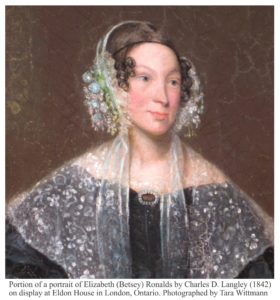
Elizabeth (Betsey) Ronalds (April 2, 1788-May 5, 1854) was an English horticultural illustrator, best remembered for the lithographs in her father Hugh Ronalds‘ renowned book Pyrus malus Brentfordiensis: or, a concise description of selected apples (1831). Her beautiful depictions of fruit and flowers enhanced the international reputation of her family’s nursery.
She was born at Brentford Butts, situated to the west of London in the town of New Brentford. Her grandparents Hugh Ronalds Sr. and Mary née Clarke had established a garden nursery there in the late 1750s, which her father developed into “one of the very best fruit nurseries in the kingdom”. It is very likely that her great-grandfather was John Ronald (no “s”) of Kilmarnock in south west Scotland, who was also a gardener. Called Betsey by relatives and friends, she was the third of ten children of Hugh and his wife (and cousin) Elizabeth née Clarke, all of whom lived to adulthood. Her only sister Mary was less than a year her senior and the two retained a close attachment through their lives. Betsey and her family were also close to their maternal and paternal cousins; of these, Sir Francis Ronalds and his brother Alfred are the best known today.
The family was of the Unitarian faith. Her grandfather had signed the 999-year lease for land on which the Brentford Society of Protestant Dissenters built Boston Chapel, and her father and brothers served as trustees and treasurer. Betsey formally joined the Society during the tenure of Nicholas Thomas Heineken and the congregation chose another “avowed Unitarian”, John Stevenson Geary, and then George W. Philp as subsequent ministers. She attended church twice on Sunday and religion was a topic of “delightful conversation” in the home. As her brother said: “We are surrounded with blessings on every side… Thus having our wants supplied, we seldom raise an eye of gratitude to Him, from whom they all descend… no! rather let us turn to the Lord… we shall learn to depend upon Him”.
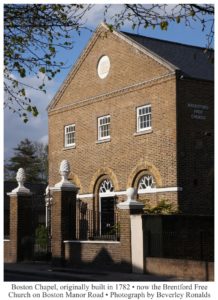
Ronalds’ values were those embodied in her religion. She believed in personal integrity and betterment, modesty, and duty to society, and was careful with her money so that she could help others less fortunate. She once wrote: “is it not more charming to make others happy by nameless little offices of love than to captivate by outward ornament. The one leads to peace, & wealth; the other to strife & poverty”. On entering a roman catholic church for the first time, in Ghent in 1816, she lamented “that so much real zeal, such talents and so much Money should be expended for the sake of rousing the passions in order to keep the people in the dark”. Her religious beliefs helped cope with death, an ever-present threat in those times, and it was a role of senior family members to foster this inner strength in younger relatives. She counselled her nephew: “I am not an advocate for dwelling with sorrow or even regret on the all wise arrangements of divine Providence, it has pleas’d our Almighty Father that our Family should not be so large as it was but we are not unhappy on that account—tho I can in memory trace more gay & cheerful days… “too gay too bright to last“.”
Ronalds’ parents encouraged a “liberal education” for the family. Her brothers boarded at the Uxbridge Academy run by Unitarian minister Thomas Ebenezer Beasley. Three of them chose to join their father’s business while others trained for careers in medicine, chemistry and law. The girls’ studies would probably have been at home and centred on literature, music, art, French, needlework, and business skills to run the household. Ronalds showed her enjoyment of the classics in a later remark concerning “a few comfortable Books… when I was your age [22] I delighted in spending hours in company with. Seneca was a great favorite; & Taylor, another; Marcus Antoninus too I lov’d very much”. She also exchanged letters in French with her younger brothers at school to assist their studies.
Notwithstanding the family’s education, Ronalds had a somewhat cloistered upbringing in Brentford that gave her a rather serious, conservative and concerned outlook on life. She was, for example, “not accustom’d to ride on horseback”, “not possessing the strongest nerves”. Later in life, she wrote of the “pleasure & confidence” she felt when favourite family members approved of her actions. She enjoyed observing the world around her, and was perceptive, but could be quite direct in the advice she then gave others; as she said: “nothing divides friends so much as reserve“. These characteristics were not necessarily typical of her circle. Her cousin Francis Ronalds displayed a light-hearted or even silly style of communication and he, his sisters and brothers enjoyed pushing boundaries and trying new things. The frequent get-togethers of the extended family would have been lively and stimulating for Ronalds.
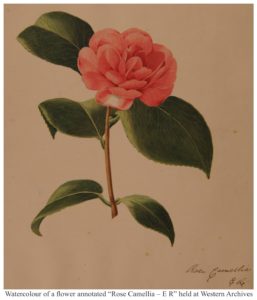
Like her sister and most of her brothers, Ronalds did not marry and they lived their lives together in the family home. Just one of her siblings had offspring and she and Mary were very much a part of this family too. Ronalds’ maternal aunt commented to her that “I wish they were your own to bring up”. The eldest of the children mused about his aunts: “I do not know… how was they never married, both good looking[?] nay very pretty I am told, one they say never had an offer [Mary] and the prettiest two [Betsey], I wonder I marvel at it, they must have loved for they are and ever have been most lovable”. When this nephew decided to migrate to Ontario Canada at age 21, it was Ronalds who provided much of the business advice and personal coaching: “Industry is the parent of wealth & Idleness of Poverty. But kindness is always felt & esteemed a kind thought… when you are establish’d in the world you will be able to give… I know nothing about your associates but I hope they are industrious, Pious People full of love to God & Man & not Profligate Spenders full of contention”.
Ronalds and her sister’s expected role in life was to keep house. Initially they assisted their mother, and they later cared for their widowed father and unmarried brothers. Mary carried the main domestic burden but it was a job that Ronalds also enjoyed; she told her nephew’s wife: “I respect you the more you devote yourself to the charming duties of Wife & Mother. We in England, that is the best sort of Women (vain enough am I not?) love the delicacies of private life with all its cares & privations”.
Ronalds and her siblings also travelled quite widely for business and pleasure. On her first trip abroad in 1816, she accompanied family and friends to Belgium, France and Switzerland. It was quite an eye-opener for her. She struggled at meals—there was “nothing simple” to eat, all “with nasty acid sauces” while French wine was “sour nasty stuff”. She nevertheless returned several times and came to enjoy the experiences of foreign travel very much. She kept detailed comments on the art and sculpture she saw in different churches, especially its quality and the emotions it aroused in her. Going to the Louvre in 1829 she was: “rather disappointed in the pictures decidedly I do not admire french painters their pictures like themselves are too much for effect & too showy”.
The family worked together in honing their own artistic skills and, although Ronalds’ talent always stood out, she would have gained confidence by trading ideas, experience and tools with her more adventurous cousins. Their art reflected their religious values in being true to life, without embellishment, and created for a useful purpose. Her cousin Francis Ronalds studied theories of perspective, and developed tracing instruments to facilitate the precise rendition of objects on paper. Alfred used Francis’ tracing instruments and Ronalds kept samples of their output in her album. All three also took interest in printmaking. They completed four books in the 1828-36 period, each of which featured highly realistic plates drawn from nature and reproduced at least in part by themselves using lithography and engraving.
Ronalds applied her artistic ability to document fruit and flowers. She painted those in the nursery as well as exotic specimens growing in the Kew Gardens and the Royal Horticultural Society’s (RHS) garden—both close by—to assist her father and brothers’ ongoing quest to extend their array of stock.
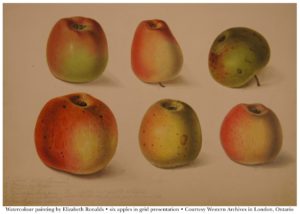
Apples feature strongly in her work, which were a specialism at the nursery. One of her approaches was to paint individual apples of different cultivars and then copy a series of them into an arrangement to facilitate their comparison. Emphasising her practical horticultural goals, she commonly (but not always) used a grid presentation, and was thereby creating a catalogue of the varieties the nursery had on offer to promote sales. Respected horticultural author John Claudius Loudon had recommended this style to assist identification, although other artists did not adopt it.
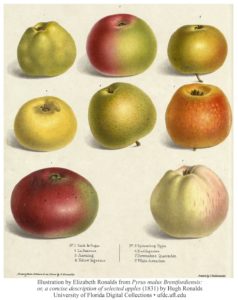
Loudon visited the nursery in 1829, where he saw Ronalds’ watercolours and described them in his Gardener’s Magazine as having “a style surpassed by no artist whatever”. Called to action by Loudon’s praise, her father published Pyrus malus Brentfordiensis about 18 months later. His summaries of the characteristics of different varieties of apple were illustrated by 42 plates depicting 179 apple cultivars. Ronalds chose lithography as the mode of reproduction, drawing the fruit on stone from her original paintings. Several of the plates were printed and signed by Charles Hullmandel, a leading lithographer in London: her cousin Francis had begun collaborating with him in 1821 and would have made the introduction. The others were not annotated and likely printed using Francis’ press—he was also creating his own lithographs in this period. The prints were then hand-coloured by the family. Ronalds supplied forty colour copies of the book for sale by the publisher Longman over the period 1831-42 and others would have been provided to friends, family and associates.

Ronalds handled the medium of lithography every bit as adroitly as pencil and paper, and reviews of her work in the literature were glowing. They highlighted that the illustrations had both “fidelity and beauty”: “the execution of the plates is so exact, that we might fancy the identical apples were before us”; they “look so deliciously tempting upon paper”. The work has been described in the 21st century by the Historian at the RHS as being “among the standard works on Horticulture” and “possibly the most beautifully illustrated of all English fruit books”.
Ronalds’ maternal cousin wrote to her in 1834: “now that you have begun a good book, in the favor of a volunteer, (always worth two press’d men) I shall think you forget me”. The new project was probably Loudon’s magnum opus Arboretum et fruticetum Britannicum (1838). Ronalds drew several of the illustrations for the work, each of which depicted an individual tree with separate details of its flowers and fruit and a branch showing the leaves. One of the specimens was growing in the Ronalds nursery.
She also provided art to other horticulturalists. In Joseph Paxton’s description of the new species Aristolochia hyperborea in his 1839 Magazine of Botany, he noted that “a beautiful figure” of the plant had been provided to him by the Ronalds nursery. Her art was being used increasingly to promote the nursery’s produce, enhance its reputation and generate goodwill-it had become a distinguishing feature in the nursery’s commercial success.
As soon as her nephew arrived in Ontario, he wrote home: “we have on the Prairie hear [sic] the most beautiful wild flowers that you can Imagine but when Aunt Betsey comes out… she must bring her paint box & then… there will be little fear of her returning to England for at least a half dozen years”. Ronalds’ planned trip to Canada did not eventuate. Her last letter to him was “full of good advice and affectionate addresses” and she died at the family home in Brentford.
Sources
All manuscript journals and letters quoted are in the Ronalds Family Papers in the Harris Family Fonds at Western Archives, Western University in London, Ontario. This archive also holds an unpublished lithograph of an artistic arrangement of apples and an album of the family’s watercolours and drawings; others are preserved by Canadian descendants. There are further materials at the Eldon House museum, also in London, Ontario. Original reviews of Pyrus malus Brentfordiensis appeared in the Literary Gazette, Philosophical Magazine, New Monthly Magazine, Gardener’s Magazine and Horticultural Register. The book is available in the University of Florida Digital Collections (ufdc.ufl.edu). The Royal Horticultural Society published a recent paper on the book and sells reproductions of several of its plates. The Ronalds nursery is described in detail in an article in Garden History (2017) and there is a short note on Betsey Ronalds in Archives of Natural History (2018). Early records of the Boston Chapel are at the London Metropolitan Archives in London, England.
Article by Beverley Ronalds
Posted May 15, 2018